Contents
Foreword to the first edition
From the preface to the first edition
Preface to the second edition
Preface to the third edition
Notation
1 Mathematical foundations
1.1 Set theory
1.2 Topology in Euclidean spaces
1.3 Operations on subsets of Euclidean space
1.4 Mathematical morphology and image analysis
1.5 Euclidean isometries
1.6 Convex sets in Euclidean spaces
1.7 Functions describing convex sets
1.7.1 General
1.7.2 Set covariance
1.7.3 Chord length distribution
1.7.4 Erosion–dilation functions
1.8 Polyconvex sets
1.9 Measure and integration theory
2 Point processes I – The Poisson point process
2.1 Introduction
2.2 The binomial point process
2.2.1 Introduction
2.2.2 Basic properties
2.2.3 Simulation
2.3 The homogeneous Poisson point process
2.3.1 Definition and defining properties
2.3.2 Characterisation of the homogeneous Poisson point process
2.3.3 Moments and moment measures
2.3.4 The Palm distribution of a homogeneous Poisson point process
2.4 The inhomogeneous and general Poisson point process
2.5 Simulation of Poisson point processes
2.5.1 Simulation of a homogeneous Poisson point process
2.5.2 Simulation of an inhomogeneous Poisson point process
2.6 Statistics for the homogeneous Poisson point process
2.6.1 Introduction
2.6.2 Estimating the intensity
2.6.3 Testing the hypothesis of homogeneity
2.6.4 Testing the Poisson process hypothesis
3 Random closed sets I – The Boolean model
3.1 Introduction and basic properties
3.1.1 Model description
3.1.2 Applications
3.1.3 Stationarity and isotropy
3.1.4 Simulation
3.1.5 The capacity functional
3.1.6 Basic characteristics
3.1.7 Contact distribution functions
3.2 The Boolean model with convex grains
3.2.1 The simplified formula for the capacity functional
3.2.2 Intensities or densities of intrinsic volumes
3.2.3 Contact distribution functions
3.2.4 Morphological functions
3.2.5 Intersections with linear subspaces
3.2.6 Formulae for some special Boolean models with isotropic convex grains
3.3 Coverage and connectivity
3.3.1 Coverage probabilities
3.3.2 Clumps
3.3.3 Connectivity
3.3.4 Percolation
3.3.5 Vacant regions
3.4 Statistics
3.4.1 General remarks
3.4.2 Testing model assumptions
3.4.3 Estimation of model parameters
3.5 Generalisations and variations
3.6 Hints for practical applications
4 Point processes II – General theory
4.1 Basic properties
4.1.1 Introduction
4.1.2 The distribution of a point process
4.1.3 Notation
4.1.4 Stationarity and isotropy
4.1.5 Intensity measure and intensity
4.1.6 Ergodicity and central limit theorem
4.1.7 Contact distributions
4.2 Marked point processes
4.2.1 Fundamentals
4.2.2 Intensity and mark distribution
4.3 Moment measures and related quantities
4.3.1 Moment measures
4.3.2 Factorial moment measures
4.3.3 Product densities
4.3.4 The Campbell measure
4.3.5 The mark correlation function
4.3.6 The probability generating functional
4.4 Palm distributions
4.4.1 Heuristic introduction
4.4.2 The Palm distribution: First definition
4.4.3 The Palm distribution: Second definition
4.4.4 Reduced Palm distributions
4.4.5 Isotropy of Palm distribution
4.4.6 Inversion formulae
4.4.7 n-fold Palm distributions
4.4.8 Palm distributions for marked point processes
4.4.9 Point-stationarity
4.4.10 Stationary and balanced partitions
4.5 The second moment measure
4.6 Summary characteristics
4.7 Introduction to statistics for stationary spatial point processes
4.7.1 General remarks
4.7.2 Edge-corrections
4.7.3 Estimation of the intensity λ
4.7.4 Estimation of the reduced second moment measure
4.7.5 Estimation of the spherical contact distribution and of the probability generating functional
4.7.6 Estimation of the nearest-neighbour distance distribution function
4.7.7 Estimation of Palm characteristics and mark distributions
4.7.8 Parameter estimation
4.7.9 Representative windows, representative volume elements
4.7.10 Hypotheses testing
4.8 General point processes
5 Point processes III – Models
5.1 Operations on point processes
5.2 Doubly stochastic Poisson processes (Cox processes)
5.2.1 Introduction
5.2.2 Examples of Cox processes
5.2.3 Formulae for characteristics of Cox processes
5.3 Neyman–Scott processes
5.4 Hard-core point processes
5.5 Gibbs point processes
5.5.1 Introduction
5.5.2 Gibbs point processes in bounded regions
5.5.3 Stationary Gibbs point processes
5.5.4 Spatial birth-and-death processes
5.5.5 Simulation of stationary Gibbs processes
5.6 Shot-noise fields
5.6.1 Definition and examples
5.6.2 Moment formulae for stationary shot-noise fields
6 Random closed sets II – The general case
6.1 Basic properties
6.1.1 Introduction
6.1.2 Random set definition
6.1.3 Capacity functional and Choquet theorem
6.1.4 Distributional properties
6.1.5 Miscellany
6.2 Random compact sets
6.2.1 Definition of means
6.2.2 Mean-value formulae for convex random sets
6.3 Characteristics for stationary and isotropic random closed sets
6.3.1 The area or volume fraction
6.3.2 The covariance
6.3.3 Contact distribution functions
6.3.4 Chord length distributions
6.3.5 Directional analysis of random closed sets
6.3.6 Intensities or densities of random closed sets
6.4 Nonparametric statistics for stationary random closed sets
6.4.1 Introduction
6.4.2 Estimation of the area or volume fraction p
6.4.3 Estimation of the covariance
6.4.4 Second-order analysis with random fields
6.4.5 Estimation of contact distributions
6.4.6 Representative volume elements
6.5 Germ–grain models
6.5.1 Basic facts
6.5.2 Formulae for p and C(r)
6.5.3 Models of mutually non-overlapping balls
6.5.4 Shot-noise germ–grain models
6.5.5 Weighted grain distributions
6.5.6 Intersection formulae
6.5.7 Statistics for motion-invariant germ–grain models
6.6 Other random closed set models
6.6.1 Gibbs discrete random sets
6.6.2 Dilated fibre and surface processes
6.6.3 Excursion sets
6.6.4 Birth-and-growth processes
6.7 Stochastic reconstruction of random sets
7 Random measures
7.1 Fundamentals
7.1.1 Introduction
7.1.2 Definitions and facts
7.1.3 Palm distributions
7.1.4 Marked random measures
7.2 Moment measures and related characteristics
7.2.1 The Laplace functional
7.2.2 Moment measures
7.3 Examples of random measures
7.3.1 Random measures constructed from point processes
7.3.2 Random measures constructed from random fields
7.3.3 Completely random measures
7.3.4 Random measures generated by random closed sets: Curvature measures
8 Line, fibre and surface processes
8.1 Introduction
8.2 Flat processes
8.2.1 Introduction
8.2.2 Planar line processes
8.2.3 Spatial line and plane processes
8.2.4 Applications of line and plane processes
8.3 Planar fibre processes
8.3.1 Fundamentals
8.3.2 Intersections of fibre processes
8.3.3 Basic statistical methods for planar fibre processes
8.4 Spatial fibre processes
8.5 Surface processes
8.5.1 Plane processes
8.5.2 General surface processes
8.6 Marked fibre and surface processes
9 Random tessellations, geometrical networks and graphs
9.1 Introduction and definitions
9.2 Mathematical models for random tessellations
9.3 General ideas and results for stationary planar tessellations
9.3.1 Point processes related to tessellations
9.3.2 Typical vertex, edge and cell
9.3.3 Zero cell
9.3.4 Mean-value relationships for stationary planar tessellations
9.3.5 The neighbourhood of the typical cell
9.4 Mean-value formulae for stationary spatial tessellations
9.5 Poisson line and plane tessellations
9.5.1 Poisson line tessellations
9.5.2 Poisson plane tessellations
9.6 STIT tessellations
9.7 Poisson-Voronoi and Delaunay tessellations
9.7.1 General
9.7.2 Planar Poisson-Voronoi tessellations (Poisson-Dirichlet tessellations)
9.7.3 Spatial Poisson-Voronoi tessellations
9.7.4 Poisson-Delaunay tessellations
9.8 Laguerre tessellations
9.9 Johnson–Mehl tessellations
9.10 Statistics for stationary tessellations
9.10.1 Reconstruction
9.10.2 Summary characteristics
9.10.3 Statistics for planar tessellations
9.10.4 Statistics for Voronoi, Laguerre and Johnson–Mehl tessellations
9.11 Random geometrical networks
9.11.1 Introduction
9.11.2 Formal definition of random geometrical networks
9.11.3 Summary characteristics of stationary random geometrical networks
9.11.4 Statistics for networks
9.11.5 Models of random geometrical networks
9.12 Random graphs
9.12.1 Introduction
9.12.2 Random graph models and their properties
10 Stereology
10.1 Introduction
10.2 The fundamental mean-value formulae of stereology
10.2.1 Notation
10.2.2 Planar and linear sections
10.2.3 Thick sections
10.2.4 Stereology for excursion sets
10.2.5 On the precision of stereological estimators
10.3 Stereological mean-value formulae for germ–grain models
10.3.1 Planar sections
10.3.2 Thick sections of spatial germ–grain models
10.3.3 Tubular structures and membranes
10.4 Stereological methods for spatial systems of balls
10.4.1 Introduction
10.4.2 Planar sections and the Wicksell corpuscle problem
10.4.3 Linear sections
10.4.4 Thick sections
10.4.5 Sieving distributions for balls
10.5 Stereological problems for nonspherical grains (shape-and-size problems)
10.5.1 General remarks
10.5.2 Two particular grain shapes
10.6 Stereology for spatial tessellations
10.7 Second-order characteristics and directional distributions
10.7.1 Introduction
10.7.2 Stereological determination of the pair correlation function of a system of ball centres
10.7.3 Second-order analysis for spatial fibre systems
10.7.4 Determination of directional distributions
References
Author index
Subject index
Wiley Series in Probability and Statistics
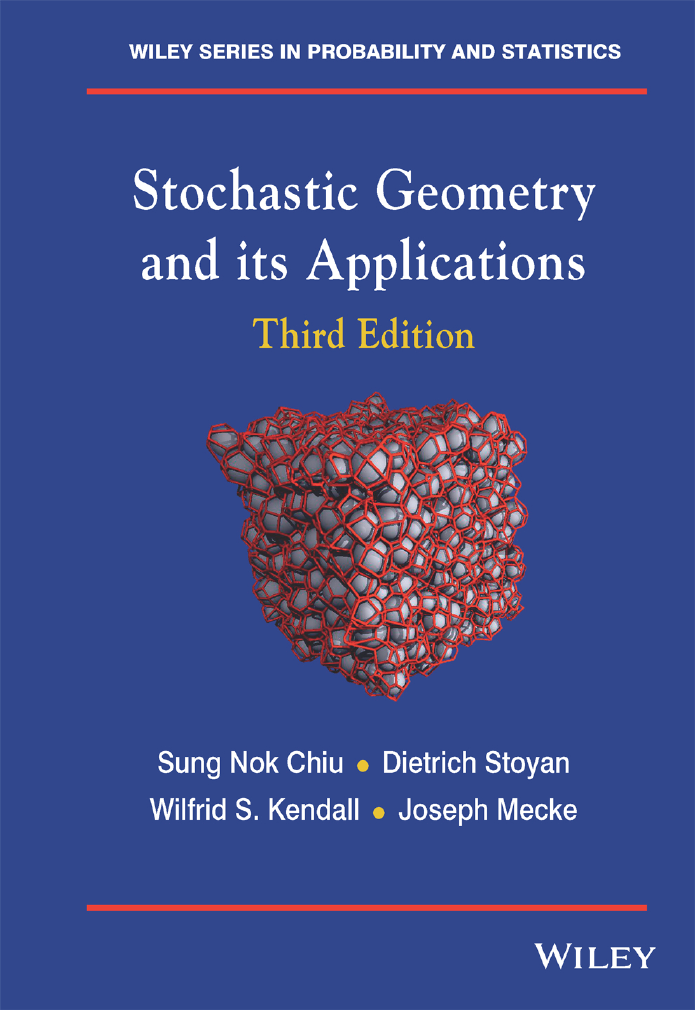

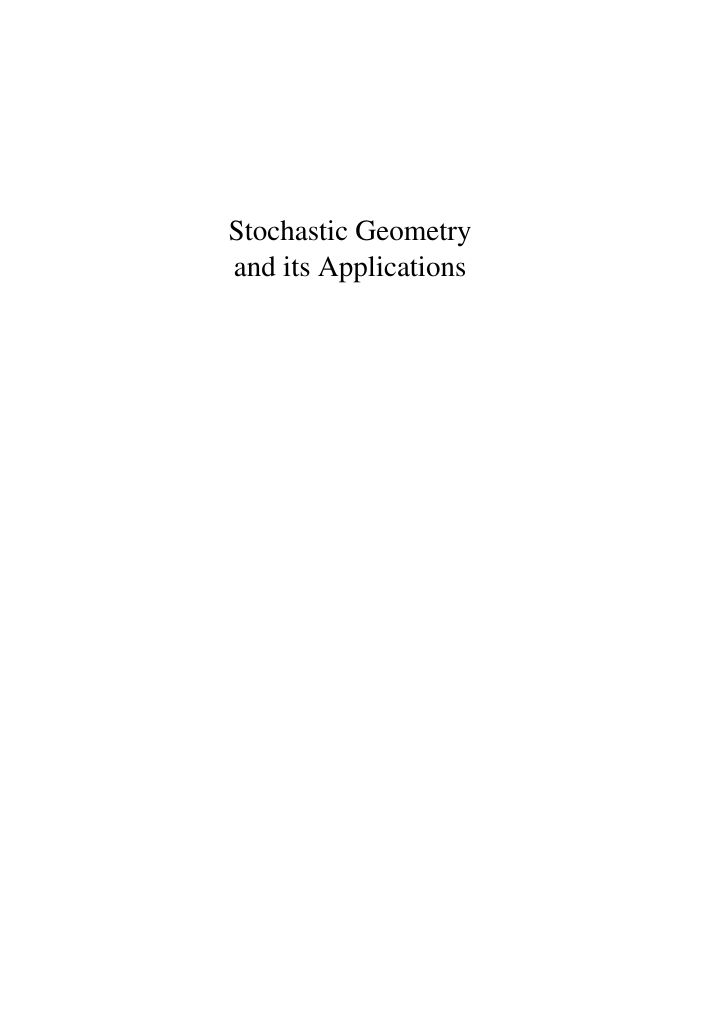
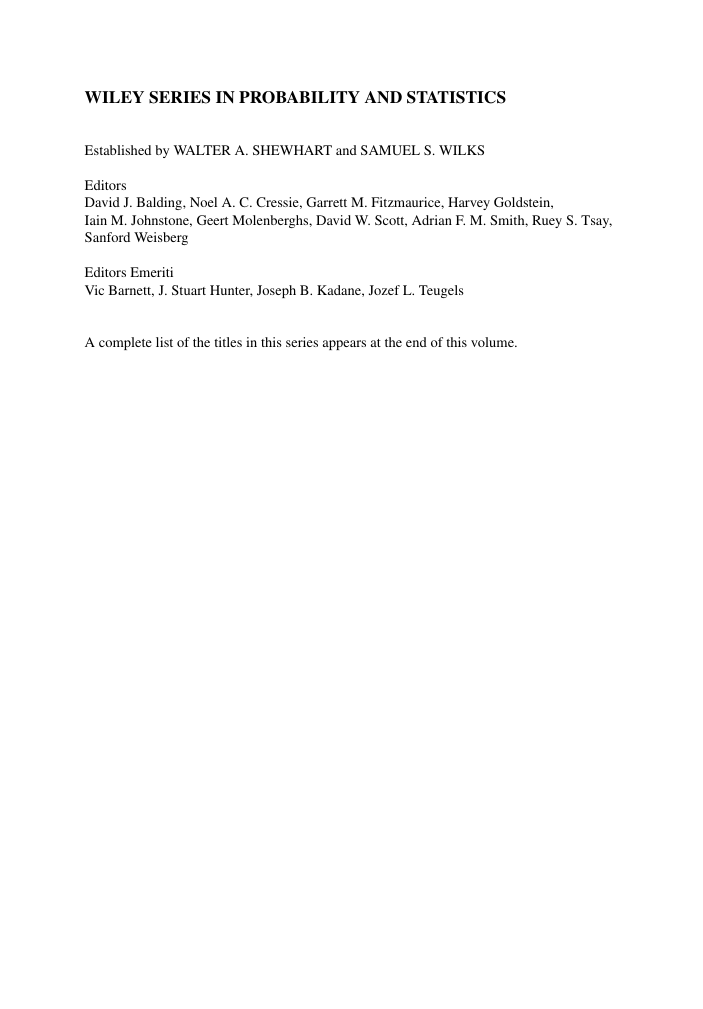

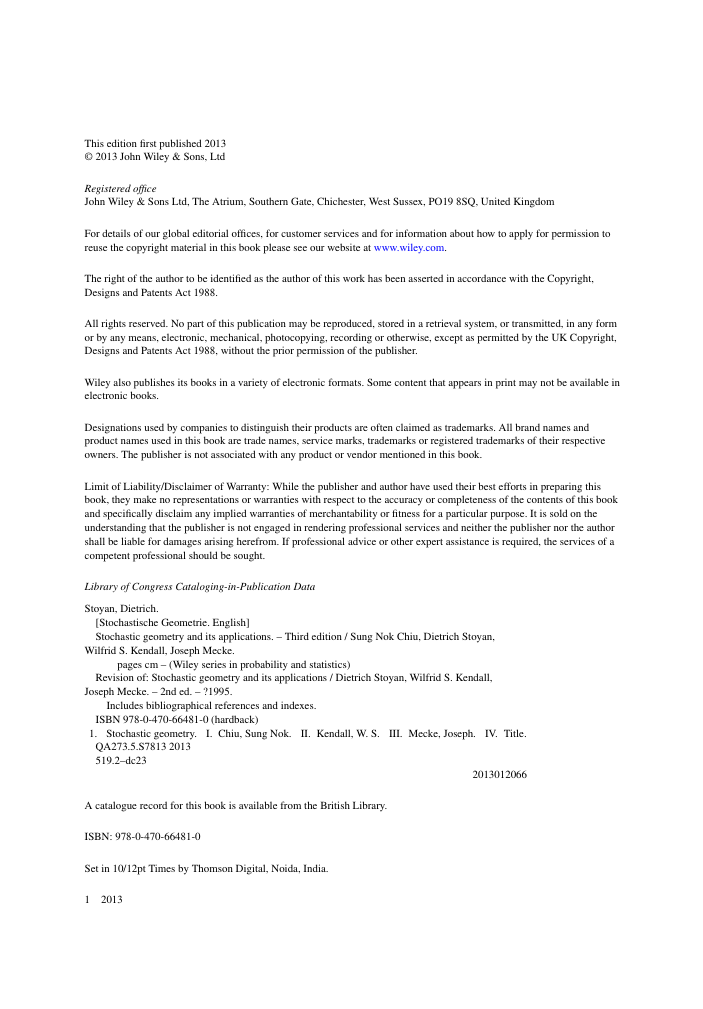
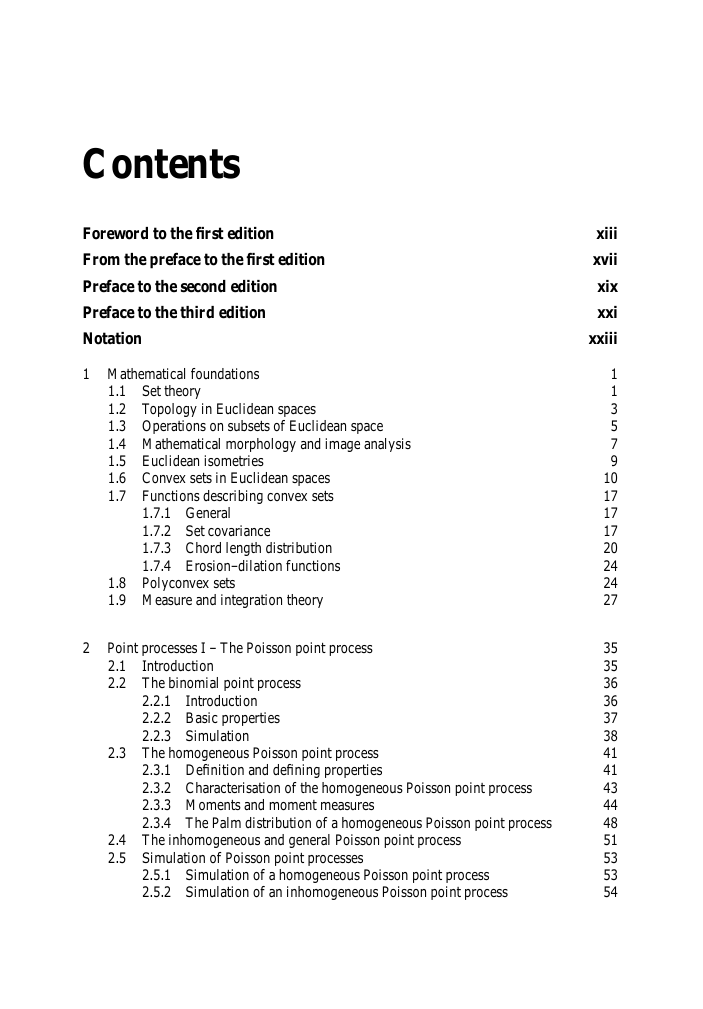
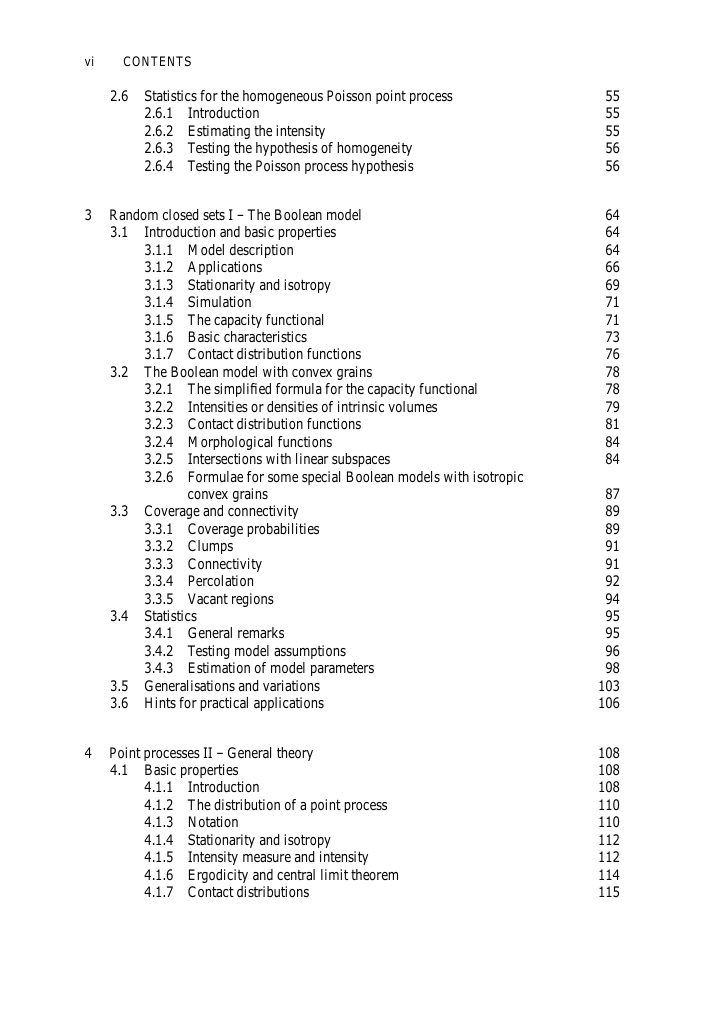








 2023年江西萍乡中考道德与法治真题及答案.doc
2023年江西萍乡中考道德与法治真题及答案.doc 2012年重庆南川中考生物真题及答案.doc
2012年重庆南川中考生物真题及答案.doc 2013年江西师范大学地理学综合及文艺理论基础考研真题.doc
2013年江西师范大学地理学综合及文艺理论基础考研真题.doc 2020年四川甘孜小升初语文真题及答案I卷.doc
2020年四川甘孜小升初语文真题及答案I卷.doc 2020年注册岩土工程师专业基础考试真题及答案.doc
2020年注册岩土工程师专业基础考试真题及答案.doc 2023-2024学年福建省厦门市九年级上学期数学月考试题及答案.doc
2023-2024学年福建省厦门市九年级上学期数学月考试题及答案.doc 2021-2022学年辽宁省沈阳市大东区九年级上学期语文期末试题及答案.doc
2021-2022学年辽宁省沈阳市大东区九年级上学期语文期末试题及答案.doc 2022-2023学年北京东城区初三第一学期物理期末试卷及答案.doc
2022-2023学年北京东城区初三第一学期物理期末试卷及答案.doc 2018上半年江西教师资格初中地理学科知识与教学能力真题及答案.doc
2018上半年江西教师资格初中地理学科知识与教学能力真题及答案.doc 2012年河北国家公务员申论考试真题及答案-省级.doc
2012年河北国家公务员申论考试真题及答案-省级.doc 2020-2021学年江苏省扬州市江都区邵樊片九年级上学期数学第一次质量检测试题及答案.doc
2020-2021学年江苏省扬州市江都区邵樊片九年级上学期数学第一次质量检测试题及答案.doc 2022下半年黑龙江教师资格证中学综合素质真题及答案.doc
2022下半年黑龙江教师资格证中学综合素质真题及答案.doc